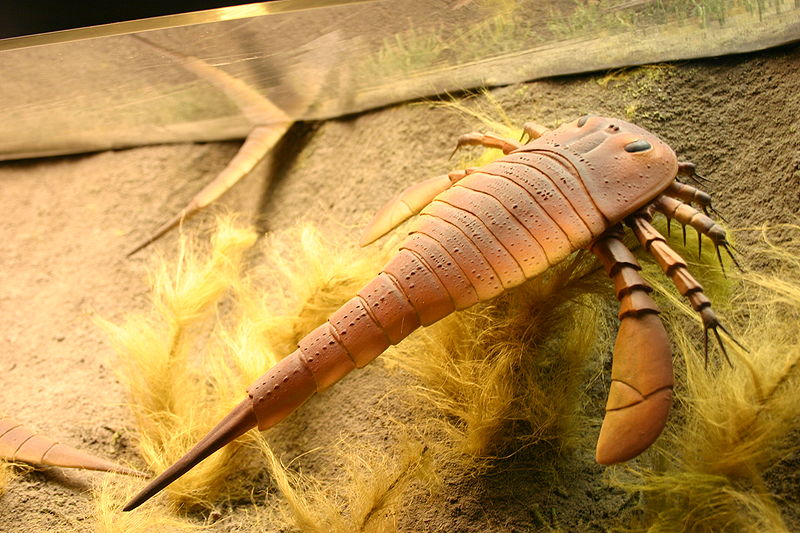
Your base model Sea Scorpion. Extra option package includes scary-looking spiked chelicerae (feeding mouthparts). Creative Commons Ryan Somma. cc-by-sa-2.0. Click for link.
A few months ago I wrote about a study by scientists at the Denver Museum of Nature and Science that showed the mighty Anomalocaris — the “terror” of the Cambrian seas — might not have been so mighty after all. Well, it’s happened again.
This time, the victim is the sea scorpion — members of the class Eurypterida (the eurypterids, “you-RIP’-ter-ids”). These remarkable creatures roamed mid-Paleozoic shallow waters, both saline and fresh, and some may have even crawled onto land to curl up in the hollow boles of tree lycopods. Though many forms were smaller, paleontologists have unearthed fossils of some marine forms that can reach seven or eight feet long, making them possibly the largest arthropods ever (and that’s saying a lot, since arthropods include all the crustaceans, insects, and arachnids).
Their fossils look a bit like scorpions that got squashed with their pincers pointing backwards — although actually, the “pincers” are the last pair of legs, modified to be paddles for swimming. Some of the squashed look may actually be due to fossilization, but probably not all — horseshoe crabs, which are also joint-legged, armored arthropods, look pretty much like they do in real life in fossil form. In short, they resemble a creature that would crawl into and nest in someone’s ear in Star Trek.
Here is how Colin Tudge describes them in The Variety of Life:
Eurypterida superficially resembled scorpions, but sometimes grew as long as a small rowing boat, and were among the most prodigious invertebrates of all time. Eurypterids should be remembered with the kind of awe with which we contemplate dinosaurs. […] Like dinosaurs, eurypterids have a sobering, Ozymandias-like quality; that such magnificent creatures, which flourished, radiated, and often dominated for nearly 250 million years, should finally have gone the way of all flesh. It would be good to have just one survivor to admire.
Up until a few weeks ago, it was thought these behemoths, along with predatory ammonites — relatives of octopus, squid and cuttlefish — were the top predators of mid-Paleozoic (the time from the Cambrian explosion to the Permo-Triassic extinction, the Great Dying that preceded the age of dinosaurs) seas. Only with the rise of jawed fishes (think sharks and placoderms) did they lose their dominance. Well, at least according to a new study, maybe not so much.
This time, scientists at the Buffalo Museum of Science in Buffalo, N.Y., were the guilty parties. They calculated once more the force required to crack into the shells of the kind of prey it’s thought sea scorpions ate — horseshoe crabs. The force the spiny pincers of a representative of one of the largest groups could produce, they found, came up short in the crab shell cracking department. About three to 12 pascals short, to be precise. What is left for our subject? Scavenging, perhaps, or (gasp!) vegetarianism, the scientists suggest.
Interestingly, eurypterids are actually, in addition to being arthropods, chelicerates. You know, chelicerates — the spiders, scorpions, ticks, mites, etc. — all animals in possession of special food-nabbing (and often food incapacitating and venom injecting — chelicerae are the things on spiders with fangs) mouthparts called chelicerae (che-LISS-er-ee). Guess who else are chelicerates? Horseshoe crabs.
Check out how eurypterids fit into the chelicerates and arthropods here. You’ll notice that in spite of their name, sea scorpions aren’t actually closely related to scorpions.The little cross (technically, a dagger) next to the group means that it has bit the big one, sadly, at the end of the Permian in the aforementioned Great Dying, unless we find some hiding out in Lake Vostok.
Will these results stand up when tested by other scientists on other specimens? Were Anomalocaris and the eurypterids really wimps? And if they weren’t the biggest, baddest, things around what was? And what’s next? T. rex a lowly scavenger? Heaven forbid.


{ 1 trackback }
{ 0 comments… add one now }